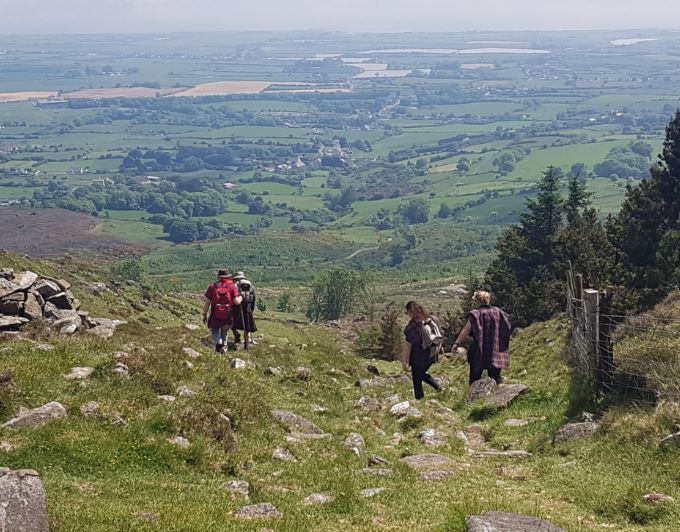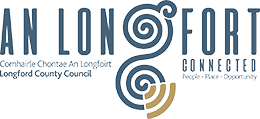The Táin Trail
The Táin Trail retraces the journey taken by Queen Meave and her armies during the Irish epic legend of Táin Bó Cuailgne. It travels from Queen Meave's palace in Rathcroghan, County Roscommon, across to Cooley Peninsula in County Louth. In addition to Roscommon and Louth, it goes through counties Meath, Westmeath and Longford.
In County Longford, the Táin Trail travels from Tarmonbarry to Granard.
See the Táin Trail map for its full 504km route and details of the legendary places you will visit. You can expect to see both famous historical sights, medieval castles, early churches and monasteries, as well as little-known sites and peaceful, rural views over mountains and by rivers and lakes.
You can choose to walk, cycle or drive part or all of the route!

Táin Bó Cuailgne
The Táin Bó Cuailgne (or the Cattle Raid of Cooley) is the most famous of Irish sagas. At 2,000 years old, it is one of the most ancient in northern Europe.
In this ancient saga, Queen Maeve of Connacht and her husband Ailill decide one night to compare their possessions. After much discussion, it becomes evident that Ailill owns a great white bull, Finnbennach, which Maeve has no equal for. There is only one bull in Ireland equal to Finnbennach, the great Brown Bull of Cooley. Maeve decides she must have the Brown Bull, and so begins the story of the Táin Bó Cuailgne.
Queen Maeve's armies set off from the Royal Palace at Rathcroghan in County Roscommon. They crossed into County Longford at the Shannon fords at Tarmonbarry. Between here and Longford town was Trego, the plain of the spears, where the armies were attacked by the Celtic war-spirit, Nemain. After an overnight halt at Granard, they advanced towards Crossakeel in County Meath, the scene of Cúchulainn’s first threat to the armies.
At Kilskeer, the armies cut down a great forest before the chariots, and then stopped for the night in Kells. It is here that Cúchulainn read the tracks of the armies to gauge their numbers, which he estimated to be 18 troops and 3,000 each.
From Kells, the route passes through Navan and Slane and close to the river Mattock, scene of the first bloody encounter between their armies and Cúchulainn and where they hear of his 'Boyhood Deeds'. The armies passed on through the 'Pig Keepers Plain' north of Drogheda and close to Monasteboice (a monastic site) to reach the 'Broad Ford' (or Dundalk Bay), where many chariots were shattered in fierce fighting.
The armies then advanced on Cooley. Here, they laid waste to the countryside in their search for the Brown Bull, who was hidden in the 'Black Cauldron' in the valley of Glenn Gat in the Cooley Mountains. They tore up the 'Cattle' or 'Windy Gap' as a mark of dishonour to Ulster. They eventually captured the bull and met at Faughart, where Cúchulainn was attacked by the war-goddess Morrigan. This is the most challenging and spectacular part of the route, as it runs along mountain roads down to Omeath, with the Mourne Mountains rising above Carlingford Lough in the distance. The lie of the land is very much the same as it was when Queen Maeve came through the Windy Gap in her pursuit of the Brown Bull.
The armies passed back along the road to Dundalk, the site of Cúchulainn’s fort, Dún Dealgan, and on to Ardee through Knockbridge. This is where badly wounded Cúchulainn slept for three days and three nights before his ferocious attack on Maeve's forces. In the later tale of his death, the Cloghafarmore (Big Man's Stone) just outside Knockbridge is said to be the pillar-stone Cúchulainn strapped himself to, as he was dying.
Ardee (Ferdia’s Ford) is the scene of the last and greatest single-combat of the Táin, when Cúchulainn fights and kills his foster brother Ferdia. Two modern sculptures on the banks of the River Dee now commemorate their fight.
As Maeve's armies began to retreat westward again, the Ulster warriors were finally woken from their sleeping spell and hastened to assist Cúchulainn. Teltown (Tailtui), near Navan, was the scene of the terrible battle of the charioteers and was one of the three great gathering places of ancient Ireland.
At 'Warriors Ford', on the Brosna River near Mullingar, King Conchobar of Ulster made a raid on the retreating armies and brought back eight score heads. The Ulster armies assembled outside Mullingar for the final great battle. Fergus vented his fury on the 'three bald topped hills' which he levelled with three strokes. The bloody battle finally ends here, and Cúchulainn watches Maeve’s armies cross back over the Shannon at Athlone, into their province.
The two bulls eventually meet and begin their battle at the Hill of Emmoo, north-east of Roscommon Town. They fight, circling the whole of Ireland, with the Brown Bull emerging victorious, but mortally wounded. He makes his final journey back across Ireland to his home in Cooley, with the remains of the white bull hanging from his horns, and so ends this epic tale.



